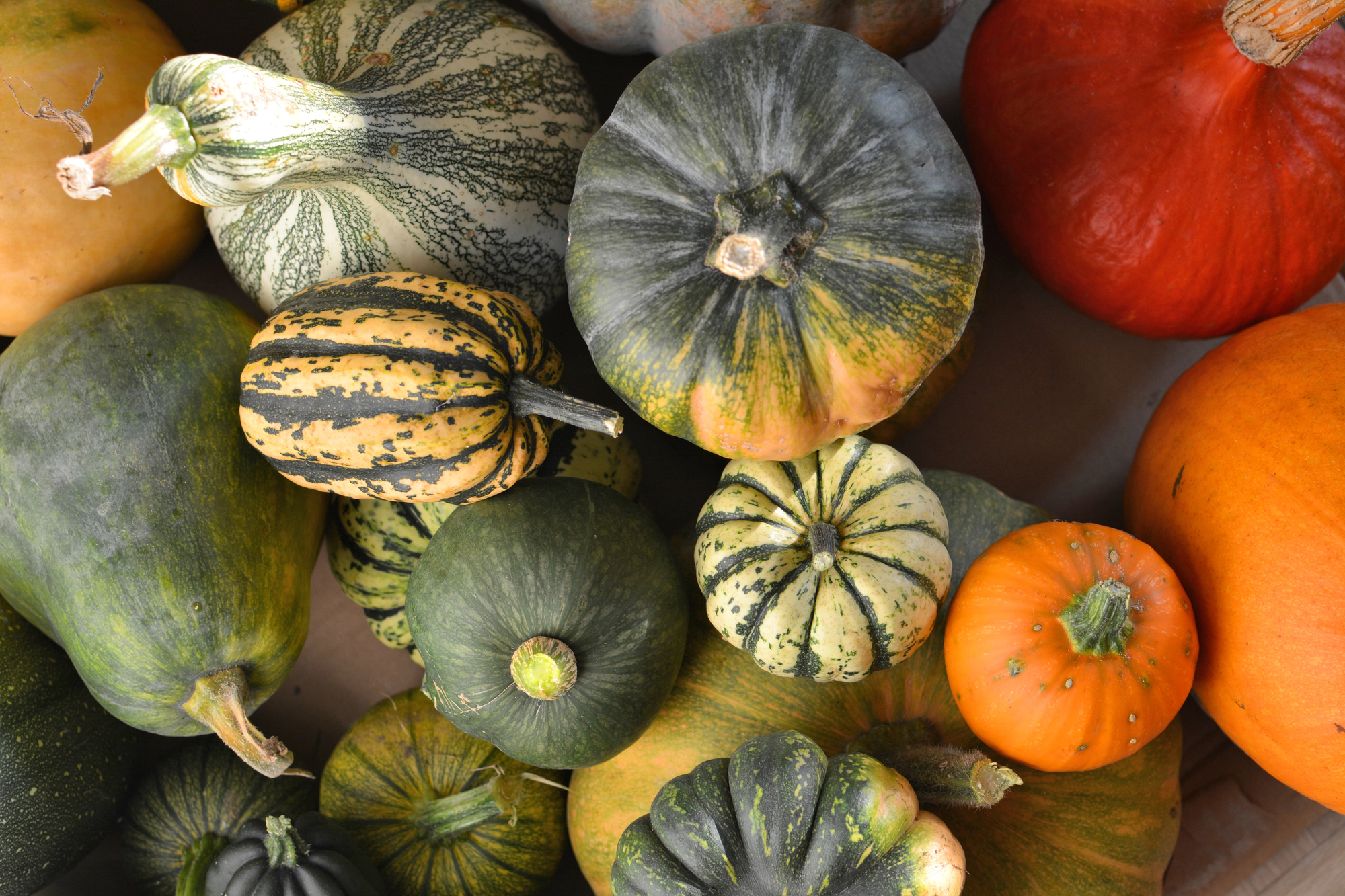Winter Squash Donation Tracker
Quick Links: How & Where to Grow | Temperature | How to Care For | Harvest Signs | Harvesting | Pruning | Storage | Pests | Varieties | Preservation | Recipes | Michigan Tips | Fun Facts
🌱 How & Where to Grow Winter Squash:
- Plant by late May when soil reaches 65°F – they need a long season!
- Need 95-120 frost-free days depending on variety.
- Space plants 3-5 feet apart for bush types, 6-8 feet for vining.
- Sunlight: Full sun (8+ hours) essential for ripening.
- Soil Type: Rich, well-drained soil with pH 6.0-6.8.
- Soil Amendment: Heavy feeders – add lots of compost and aged manure
Winter squash takes patience but rewards with months of storage – grow your own winter food supply!
🌡️ Temperature Guidance:
Minimum 65°F soil. Cold stunts permanently.
- Planting: Wait for consistent 65°F soil temperature.
- Growing: Thrives at 70-85°F air temperature.
- Very sensitive to cold – growth stops below 50°F.
- Can tolerate light frost when mature but not when young.
Michigan’s short season means choosing varieties carefully – every day counts!
💧 How to Care for:
- Consistent Moisture: Critical during fruit development.
- Watering: Deep watering weekly – 1-2 inches.
- Mulch: Heavy mulch controls weeds and retains moisture.
- Fertilizer: Side-dress when vines begin to run.
- Vine direction: Train vines away from paths early.
📏 Harvest Signs:
Stem brown/corky. Hard rind. Color deepens. Vines dying back.
- The stem tells the story – when it’s brown and corky, squash is ready!
- Rind should be hard – can’t dent with fingernail.
- Color deepens to mature shade for variety.
- Sounds hollow when thumped.
- Ground spot turns from white to cream/orange.
Harvest before hard freeze but after full maturity for best storage!
🧺 Harvesting:
Cut with 2-inch stem. Handle carefully. Cure immediately.
- Always cut stem with sharp knife – never pull from vine.
- Leave 2-3 inch stem for better storage.
- Handle like eggs – bruising shortens storage life.
- Harvest on dry day when vines are dry.
- Work quickly if frost threatens – even mature squash damaged by hard freeze.
✂️ Pruning:
Tip vines at 10 feet. Remove late flowers. Limit fruits for size.
- Pinch growing tips when vines reach 10-12 feet to focus energy.
- Remove flowers after mid-August – won’t mature before frost.
- For large squash: Allow only 2-3 fruits per vine.
- Remove damaged or diseased leaves throughout season.
- Redirect vines away from paths and other plants.
📦 Storage:
Cure at 80-85°F for 10-14 days. Store 50-55°F for 3-6 months.
- Curing is essential – hardens skin and heals wounds.
- Cure in warm spot – 80-85°F with good ventilation.
- After curing, store at 50-55°F with 50-70% humidity.
- Don’t store near apples – ethylene gas causes spoilage.
- Check regularly and use any with soft spots first.
- Different varieties store differently – butternut longest, delicata shortest.
🪲 Michigan Pests:
Vine borers (worse on vining types), squash bugs, cucumber beetles.
- Squash vine borers – devastating! Choose bush types or plant late.
- Squash bugs – bronze eggs on leaf undersides, destroy immediately.
- Cucumber beetles – spread bacterial wilt, use row covers.
- Powdery mildew – inevitable late season, choose resistant varieties.
🎃 Varieties:
‘Waltham Butternut’, ‘Burgess Buttercup’, ‘Cornell Bush Delicata’.
- ‘Waltham Butternut’: 105 days, excellent storage, classic flavor.
- ‘Burgess Buttercup’: 95 days, sweet orange flesh, good keeper.
- ‘Cornell Bush Delicata’: 80 days, space-saving bush habit.
- ‘Table Queen Acorn’: 80 days, early and reliable.
- ‘Blue Hubbard’: 120 days, huge but excellent storage.
🫙 Preservation:
Root cellar ideal. Freeze cooked. Pressure can cubed. Dehydrate.
- Root cellar: Best method – properly cured squash lasts months.
- Freezing: Cook first – cube, mash, or puree before freezing.
- Pressure canning: Only safe method for canning – never water bath.
- Dehydrating: Slice thin for chips or rehydratable pieces.
- Whole storage: Some varieties keep 6-8 months properly stored!
- Seeds: Roast seeds like pumpkin seeds for snacks.
🧑🏽🍳 Recipes:
Butternut soup, stuffed acorn squash, squash ravioli.
- Creamy butternut squash soup with sage.
- Stuffed acorn squash with wild rice and cranberries.
- Roasted delicata rings – no peeling needed!
- Spaghetti squash as pasta substitute.
- Squash pie – like pumpkin pie but often better!
✋🏼 Michigan Tips:
- Choose 90-100 day varieties maximum.
- Start seeds indoors 3 weeks early for head start.
- Use black plastic mulch to warm soil.
- Bush varieties avoid some vine borer damage.
- Plant by Memorial Day for full maturity.
- Row covers early season speed growth.
🧠 Fun Facts:
- Same species as pumpkins.
- Part of Three Sisters.
- Some store 6-8 months.
- Native Americans buried squash in sand for winter storage.
- Butternut squash wasn’t developed until the 1940s!
- Seeds from 10,000-year-old squash found in Mexican caves.
- Squash blossoms were more important than fruit to some tribes.
- The word “squash” comes from Native American “askutasquash.”


0 Comments